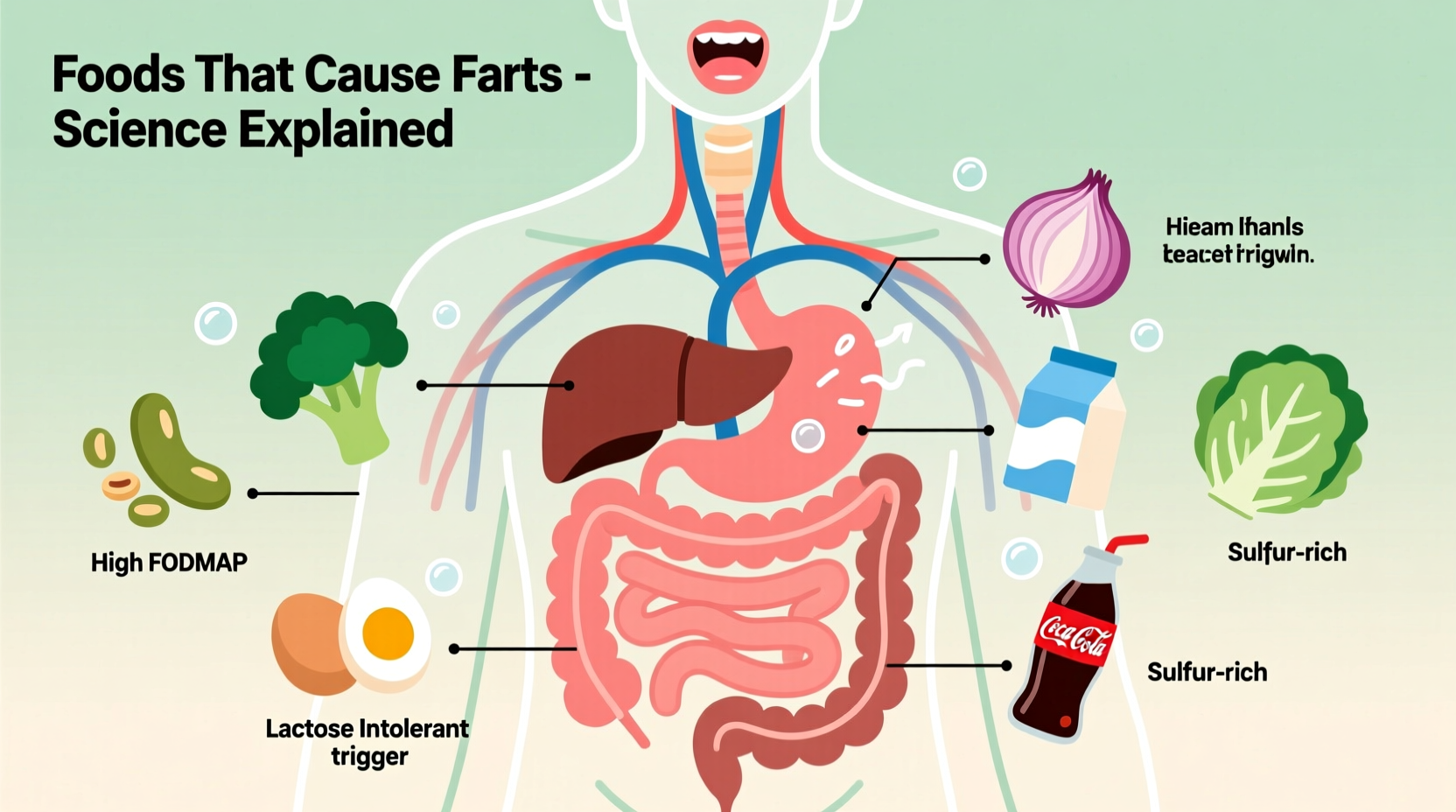Understanding which foods cause gas isn't just about avoiding embarrassment—it's about recognizing how your digestive system processes different nutrients. Gas production is a normal part of digestion, but certain foods trigger excessive flatulence in many people due to their unique chemical composition and how gut bacteria interact with them.
Why Certain Foods Make You Gassy: The Science Simplified
Gas forms when undigested carbohydrates reach your large intestine, where trillions of bacteria ferment them through a process called colonic fermentation. This natural digestive process produces hydrogen, methane, and carbon dioxide. While everyone experiences gas (passing gas 14-23 times daily is medically normal), specific foods contain compounds that feed gas-producing bacteria more effectively.
According to the National Institute of Diabetes and Digestive and Kidney Diseases, the primary culprits are fermentable oligosaccharides, disaccharides, monosaccharides, and polyols (FODMAPs)—short-chain carbohydrates that resist digestion in the small intestine.
Your Gas-Trigger Food Guide: What to Watch For
Legumes and Pulses: The Classic Gas Producers
Beans, lentils, and chickpeas contain raffinose—a complex sugar your small intestine can't break down. When gut bacteria ferment raffinose in your colon, they produce significant gas. Soaking dried beans for 8-12 hours before cooking reduces raffinose content by up to 25%, according to research published in Nutrients.
Dairy Products: When Lactose Becomes Problematic
If you're lactose intolerant (affecting 68% of the global population per NIH studies), dairy causes gas because your body lacks lactase—the enzyme needed to digest milk sugar. Hard cheeses and yogurt typically cause less gas than milk or soft cheeses since they contain less lactose.
Cruciferous Vegetables: Healthy but Gassy
Broccoli, cauliflower, Brussels sprouts, and cabbage contain raffinose and sulfur compounds. While sulfur gives these vegetables their cancer-fighting properties, it also creates that distinctive odor in flatulence. Cooking these vegetables reduces their gas-producing potential by breaking down some complex fibers.
| Food Category | Common Gas-Producing Foods | Time to Gas Production | Gas Severity Level* |
|---|---|---|---|
| Legumes | Beans, lentils, chickpeas | 60-120 minutes | ★★★★☆ |
| Dairy | Milk, soft cheeses, ice cream | 30-120 minutes | ★★★☆☆ |
| Cruciferous Veggies | Broccoli, cauliflower, cabbage | 90-150 minutes | ★★★☆☆ |
| Fruits | Apples, pears, peaches | 60-100 minutes | ★★☆☆☆ |
| Grains | Wheat, barley, rye | 90-180 minutes | ★★☆☆☆ |
*Severity based on frequency and volume of gas produced in clinical studies. Individual reactions vary.
Practical Strategies to Reduce Gas Discomfort
Gradual Introduction Technique
Rather than eliminating gas-producing foods completely—which removes valuable nutrients—try the gradual introduction method. Start with small portions (¼ cup beans) and slowly increase over 2-3 weeks. Your gut microbiome adapts by developing more efficient bacteria, reducing gas production significantly. A Mayo Clinic study found this approach reduced gas symptoms by 54% in participants with sensitive digestion.
Smart Food Preparation Methods
Certain cooking techniques break down gas-producing compounds:
- Soaking and rinsing: Soak dried beans overnight, then discard water before cooking
- Thorough cooking: Cook vegetables until tender-crisp rather than raw
- Enzyme assistance: Use products containing alpha-galactosidase (like Beano) with bean dishes
Timing Matters: When to Eat Gas-Producing Foods
Consuming gas-trigger foods earlier in the day gives your digestive system more time to process them before bedtime. Avoid combining multiple high-gas foods in one meal—this compounds the effect. For example, don't eat beans with broccoli and carbonated drinks simultaneously.

When Gas Signals Something More Serious
While occasional gas is normal, consult a healthcare provider if you experience:
- Persistent bloating lasting more than 24 hours
- Gas accompanied by diarrhea lasting over 2 weeks
- Unintentional weight loss with increased gas
- Blood in stool
These could indicate conditions like irritable bowel syndrome (IBS), small intestinal bacterial overgrowth (SIBO), or celiac disease. The American Gastroenterological Association notes that sudden changes in gas patterns warrant medical evaluation, especially if they disrupt daily activities.
Building Your Personal Gas-Trigger Profile
Everyone's digestive system reacts differently. Keep a 2-week food and symptom journal tracking:
- Foods consumed (include portion sizes)
- Time of consumption
- Gas symptoms (timing, severity, duration)
- Other digestive symptoms
This personalized approach helps identify your specific triggers rather than eliminating all potentially gassy foods unnecessarily. Most people discover they're sensitive to just 2-3 categories, not all gas-producing foods.
Frequently Asked Questions
Does drinking water help reduce gas?
Yes, drinking adequate water helps move gas through your digestive tract more efficiently. Dehydration slows digestion, allowing gas to build up. Aim for 8-10 glasses daily, but avoid gulping large amounts during meals as this can introduce air into your digestive system.
Are there foods that naturally reduce gas?
Ginger, peppermint, and chamomile tea can help relax digestive muscles and move gas along. Fennel seeds contain compounds that reduce intestinal spasms. Probiotic-rich foods like kefir and sauerkraut may improve gut bacteria balance over time, potentially reducing gas production from certain foods.
Why do some people experience more gas than others?
Individual differences in gut microbiome composition, digestive enzyme production, and intestinal transit time affect gas production. Some people naturally produce more methane-dominant gut bacteria, which creates more noticeable gas. Genetic factors also influence lactase production, explaining why some tolerate dairy better than others.
How long after eating do gas symptoms typically appear?
Gas symptoms usually begin 30-120 minutes after eating gas-producing foods, depending on the food type and your digestive speed. Simple sugars like fructose may cause gas within 30 minutes, while complex fibers like raffinose in beans typically take 60-120 minutes to reach the colon where fermentation occurs.
Can cooking methods reduce gas from vegetables?
Yes, proper cooking breaks down complex fibers that cause gas. Steam or boil cruciferous vegetables until tender-crisp rather than eating them raw. Roasting at high temperatures (400°F/200°C) caramelizes sugars and breaks down gas-producing compounds. Avoid overcooking, which destroys valuable nutrients while providing minimal additional gas reduction.











 浙公网安备
33010002000092号
浙公网安备
33010002000092号 浙B2-20120091-4
浙B2-20120091-4